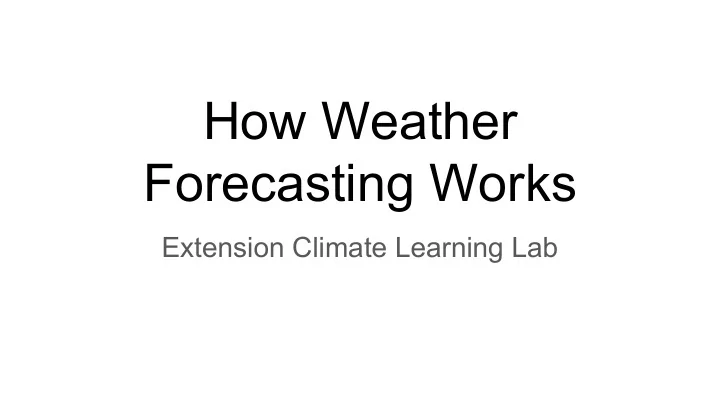

How Weather Forecasting Works Extension Climate Learning Lab
Forecasting Weather ● Weather data is collected from weather stations, and also weather satellites, doppler radar, weather balloons, and other tools. ● It is then compiled and analyzed by powerful computers that identify patterns. ● Those computer then use models to predict how the patterns found will affect the weather. ● Accurate weather prediction is only possible in the short term. ● Tomorrow’s forecast is likely fairly accurate but next week’s may still change. 2
Weather Forecasting Graphic Forecasters interpret the data and graphics to Data is make forecasts processed by Computers computer create graphics models based on data. Data is collected 💼 in a variety of ways. 3 Weather Forecaster icon by Llisole from the Noun Project
Data Collection Atmospheric Conditions ● Doppler Radar ● Weather Satellites ● Weather Balloons/Radiosondes Surface Conditions ● Automated Surface Observing Systems (ASOS) ● Cooperative Observer Program (COOP) ● Other 4
Doppler Radar Equipment In the U.S. there are 159 Doppler Radar sites. 5
Doppler Radar Data Doppler Radar image (https://radar.weather.gov/ridge/Conus/full_lite.php) Radar uses microwaves to “see” (detect) water droplets in the atmosphere and allows us to map where rain and other types of precipitation is and how it is moving. 6
Doppler Radar Extreme Weather The rotation of thunderstorm clouds and tornadoes and the debris they carry, as well as wind strength and direction can be measured by Doppler Radar. https://www.nssl.noaa.gov/education/svrwx101/tornadoes/detection/ 7
Weather Satellites ● We also get information about our weather from well above the surface of the Earth. ● Three different kinds of weather satellites take measurements and provide information. ● Polar satellites orbit the poles. ● Deep space satellites face away from the Earth and collect data about the sun (which impacts Earth’s weather). ● Geostationary satellites stay in one location and provide data about that area every 30 seconds. 8
Geostationary Satellites GOES Graphic, NOAA Photo Library, Public Domain, 9 https://commons.wikimedia.org/wiki/File:GOES_8_Spac0255.jpg
Geostationary Satellite Data Geostationary Satellite image of the Western U.S., https://www.goes.noaa.gov/goes-w.html 10
Weather Balloons ● Weather balloons carrying radiosondes are deployed from 92 locations around the U.S. twice per day. ● The radiosondes collect data about the conditions in the upper stratosphere as the balloon they are attached to float upwards http://www.noaa.gov/news/fifty-years-ago-historic-balloon-launch-changed-way-we-see- ozone-layer (Image credit: Theo Stein/NOAA) during a two hour trip. 11
Weather Balloons: Radiosondes Radiosondes are small instruments that are attached to weather balloons and launched straight up into the atmosphere. Radiosondes send back data via radio waves every second about air pressure, temperature, relative humidity, wind speed, and wind direction. https://www.weather.gov/images/ohx/upperair/baseline.jpg 12
Surface Conditions Weather conditions at Earth’s surface are collected in many places in a few different ways. 13
Automated Surface Observing Systems (ASOS) The U.S. has Automated Surface Observing http://www.nws.noaa.gov/mirs/public/prods/ Systems (ASOS) which consists of more than 900 stations across the U.S. maps/natl_asos.htm These stations report data about sky conditions, surface visibility, precipitation, temperature, and wind up to 12 times an hour. https://www.weather.gov/asos/ 14
Cooperative Observer Program In addition to ASOS, since 1890, the US has relied on a network of volunteers called the Cooperative Observer Program to provide weather reports from around the country. There are now more than 8,700 volunteers who go through training and then send daily weather data from locations where automated stations are not installed. 15 https://www.weather.gov/coop/
Other Surface Condition Collection Methods ● Buoys on ocean and lakes. ● River gauges https://commons.wikimedia.org/wiki/File: NOAA-NDBC-discus-buoy.jpg https://water.weather.gov/ahps/index.php 16
Data Analysis and Modelling ● Supercomputers https://www.weather.gov/about/supercomputers 17
Data Output for Forecasting ● Advanced Weather Information Processing System (AWIPS) https://upload.wikimedia.org/wikipedia/commons/5/57/AWIPS-3-head-workstation.jpg 18
Recommend
More recommend